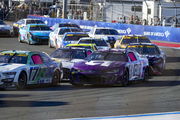
USA Today via Reuters
Feb 19, 2023; Daytona Beach, Florida, USA; NASCAR Cup Series driver Ricky Stenhouse Jr (47) leads Joey Logano (22) on the last lap as Kyle Larson (5) crashes with Travis Pastrana (67) during the Daytona 500 at Daytona International Speedway. Mandatory Credit: Mark J. Rebilas-USA TODAY Sports

USA Today via Reuters
Feb 19, 2023; Daytona Beach, Florida, USA; NASCAR Cup Series driver Ricky Stenhouse Jr (47) leads Joey Logano (22) on the last lap as Kyle Larson (5) crashes with Travis Pastrana (67) during the Daytona 500 at Daytona International Speedway. Mandatory Credit: Mark J. Rebilas-USA TODAY Sports
In motorsports, rain tires have long been a game changer, allowing races to continue under damp and wet conditions. Formula 1, IndyCar, and sports car racing have all successfully utilized wet weather tires to keep the action going, preventing unnecessary delays and cancellations. However, despite technological advancements in tire design, NASCAR remains largely resistant to rain tires on its high-speed superspeedways like Daytona and Talladega.
While NASCAR has adopted rain tires for road courses and even tested them on short ovals, using them on high-banked superspeedways remains an uncharted territory and also a controversial discussion. Could that change in the future? Veteran NASCAR insider Bob Pockrass recently weighed in on the debate, offering a perspective that suggests a change is both likely and unlikely – at least for now.
ADVERTISEMENT
Article continues below this ad
Pockrass dismisses rain tires for Daytona but leaves the door slightly open
A discussion on Twitter (X) recently sparked interest in whether NASCAR would ever introduce rain tires for Daytona. One user posed the question directly, asking if it was possible to see such an innovation in the future. Pockrass responded with cautious skepticism, stating: “Never say never, but I’d be mildly surprised for a rain tire for the high-banked superspeedway ovals. Certainly not to race in the rain. As far as to be able to race in the damp after rain stops, maybe, but years and years down the road.”
Never say never but I’d be mildly surprised for a rain tire for the high-banked superspeedway ovals. Certainly not to race in the rain. As far as to be able to race in the damp after rain stops, maybe, but years and years down the road. https://t.co/Yv6jNH8rZA
— Bob Pockrass (@bobpockrass) February 9, 2025
This response highlights the reluctance NASCAR has when it comes to using rain tires on superspeedways, citing long-term considerations rather than outright rejection. Soon after, another user took a more critical stance, arguing that NASCAR acts like it’s reinventing the wheel with rain tires when other racing series have already been using it for eons.
Pockrass then responded with a more technical explanation, clarifying that oval racing presents unique challenges that make implementing rain tires far more complex than it seems: “Ovals are somewhat unique because of the tires (with different tires for the left side and the right side), the heat generated by the tires on an oval, and because, depending on the size of the track and how bunched up the cars are, the amount of spray generated/visibility issues.”
What’s your perspective on:
Is NASCAR's resistance to rain tires at superspeedways a safety measure or just outdated thinking?
Have an interesting take?
His explanation offers critical insight into why NASCAR continues to avoid rain tires at superspeedways, revealing the deeper technical concerns that go beyond simply equipping cars with grooved wet-weather tires.
Trending
Pros and Cons of rain tires at Daytona
While the idea of rain tires at Daytona sounds like a logical step forward, there are several technical reasons why it hasn’t been implemented. But there are some reasons as to why it should be a compulsion.
- Less delays and postponements: Rain tires could allow racing to resume sooner after a rain delay, reducing disruptions in the schedule.
- More strategic racing: Teams would have to adapt to changing conditions, adding an extra layer of skill and unpredictability to races like F1.
- Increased fan engagement: Fewer rainouts mean happier fans, both at the track and watching at home.
ADVERTISEMENT
Article continues below this ad
Major challenges and safety risks
- Hydroplaning at 190+ MPH: Daytona and Talladega feature speeds exceeding 190 mph in tight packs. Even with grooved tires, standing water could lead to catastrophic hydroplaning (tire grip on water) and multi-car crashes.
- Visibility and spray issues: With cars racing nose to tail in packs, the spray generated by rain tires could severely limit visibility, making accidents far more likely.
- Banking and water drainage: Daytona’s 31-degree banking means water can pool in certain areas, making wet racing unpredictable and dangerous.
Given these challenges, it’s no surprise that NASCAR has avoided pushing rain tire development for superspeedways. The risks may far outweigh the benefits, at least with current technology.
ADVERTISEMENT
Article continues below this ad
This would require extensive R&D and testing, and even then, it could take years before NASCAR considers implementing them at Daytona or Talladega. For now, NASCAR remains firm in prioritizing safety over innovation in this area. While road courses and short tracks may see more rain racing in the future, Daytona’s superspeedway format simply presents too many risks at the moment.
Could that change with advancements in technology? Let us know in the comments.
ADVERTISEMENT
ADVERTISEMENT
ADVERTISEMENT
ADVERTISEMENT







Is NASCAR's resistance to rain tires at superspeedways a safety measure or just outdated thinking?